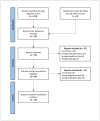Ultra-Processed Food and Its Impact on Bone Health and Joint Diseases: A Scoping Review
- PMID: 40218946
- PMCID: PMC11990240
- DOI: 10.3390/nu17071188
Ultra-Processed Food and Its Impact on Bone Health and Joint Diseases: A Scoping Review
Abstract
Background/Objectives: This scoping review explores the relationship between ultra-processed food (UPF), bone health, and joint diseases, focusing on its potential impact on bone mineral density (BMD), osteoporosis, osteoarthritis, and inflammatory arthritis, including rheumatoid arthritis (RA), gout, and spondyloarthritis. Methods: A search strategy was developed using key terms such as "ultra-processed food" and related terms like "fast food," alongside various definitions of bone health impairment, chronic degenerative joint diseases, and inflammatory arthritis. Results: A total of 19 studies were included: 12 on bone health, 3 on osteoarthritis, and 4 on inflammatory arthritis. Preclinical studies showed that UPF consumption negatively affects bone structure and strength. In studies on children and adults, four investigations (2013-2017) found no association between fast food intake and BMD. However, more recent large-scale cross-sectional studies linked higher UPF consumption to lower BMD, increased osteoporosis risk, and greater prevalence of osteopenia, particularly in postmenopausal women. UPF intake was associated with knee osteoarthritis risk, with evidence suggesting an interaction with cartilage thickness, though no association was found for hip osteoarthritis. In inflammatory arthritis, UK Biobank data indicated a higher risk of RA and gout in UPF consumers, while a Brazilian study reported worse metabolic profiles in RA patients. No significant differences in UPF intake were found in spondyloarthritis. Conclusions: This review highlights relevant considerations about the deleterious role of UPF on bone health and joint diseases, providing additional evidence to suggest healthier dietary patterns to patients and to the general population.
Keywords: bone; food; gout; osteoarthritis; osteoporosis; rheumatoid arthritis; ultra-processed.
Conflict of interest statement
The authors declare no conflicts of interest.
Figures
References
-
- Wang L., Du M., Wang K., Khandpur N., Rossato S.L., Drouin-Chartier J.-P., Steele E.M., Giovannucci E., Song M., Zhang F.F. Association of Ultra-Processed Food Consumption with Colorectal Cancer Risk among Men and Women: Results from Three Prospective US Cohort Studies. BMJ. 2022;378:e068921. doi: 10.1136/bmj-2021-068921. - DOI - PMC - PubMed
-
- Baker P., Machado P., Santos T., Sievert K., Backholer K., Hadjikakou M., Russell C., Huse O., Bell C., Scrinis G., et al. Ultra-Processed Foods and the Nutrition Transition: Global, Regional and National Trends, Food Systems Transformations and Political Economy Drivers. Obes. Rev. 2020;21:e13126. doi: 10.1111/obr.13126. - DOI - PubMed
Publication types
MeSH terms
LinkOut - more resources
Full Text Sources
Medical


